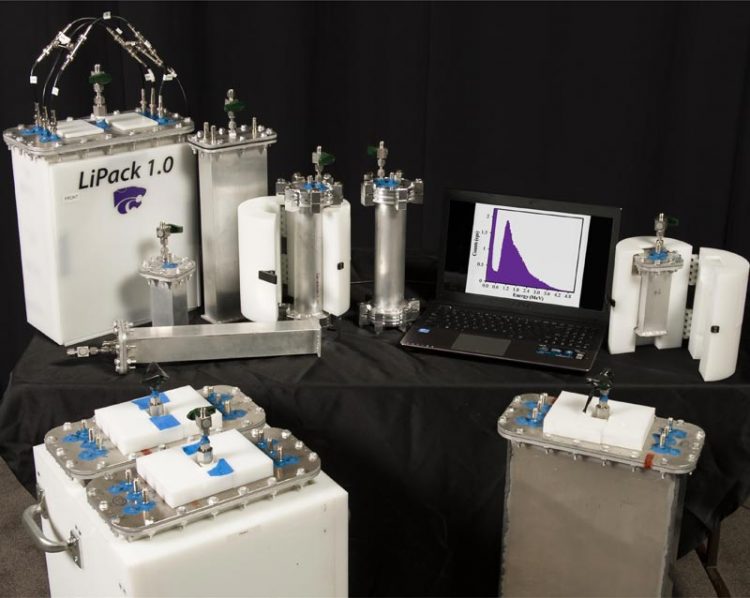Lithium-Based Neutron Detector Named Among Top 100 Technologies of the Year

Kansas State University Kansas State University engineers have developed a lithium-based neutron detector that is being recognized as one of the year's Top 100 newly developed technologies.
R&D Magazine is recognizing Douglas McGregor, professor of mechanical and nuclear engineering, and his research team with a 2014 R&D 100 Award. The award recognizes the year's 100 most significant high-technology new products.
The university-developed lithium-based neutron detector, called the Li-Foil Neutron Detector, can be used for medical imaging, national security, scientific research, oil well logging and the automotive industry.
“We are honored to receive this international recognition for the collaborative efforts of students, faculty and researchers on our team,” McGregor said. “All of the members of our team have worked very hard to advance this technology and take it to a whole new level. We continue to improve it and develop newer models.”
An R&D 100 Award signifies that a product has merit as one of the most innovative new ideas of the year, nationally and internationally, and is recognized as a mark of excellence by national laboratories, universities, industrial companies and government agencies. The award honors technology developments that are designed to meet current or future societal, scientific or business challenges.
Researchers in McGregor's Semiconductor Materials and Radiological Technologies Laboratory, or SMART Laboratory, created the Li-Foil neutron detector. Other researchers involved include Kyle Nelson, research associate in mechanical and nuclear engineering; Steven Bellinger, research associate in mechanical and nuclear engineering; Niklas Hinson, recent bachelor's graduate in mechanical engineering, Goddard; and Benjamin Montag, doctoral student in nuclear engineering, Manhattan.
Nelson, who worked on the research for his doctoral project, created the neutron detector by stacking very thin sheets of lithium foil between multiple electrodes. Lithium-based neutron detectors are more cost-effective than helium-3 based neutron detectors.
“The relatively low cost of the detector is a direct result of the advancements in lithium foil manufacturing in the lithium battery industry,” Nelson said.
Helium-3 is often used in neutron-based technology, but is rare and expensive, McGregor said. Lithium-6 is a metal that is highly reactive with neutrons and Kansas State University researchers have shown that it is a good alternative for neutron detection.
As a result, the lithium-based detector has several different applications, including stationary detectors that can be used at U.S. ports of entry, mobile backpack neutron detectors, and handheld devices.
“Our lithium-based technology seems to solve many of the problems in neutron detection,” Nelson said. “Because lithium is less expensive, we have the capability to make some of the stationary detectors as big as bookshelves, which can help the detectors be even more accurate.”
Bellinger, who founded the Manhattan-based start-up company called Radiation Detection Technologies Inc., is helping with the commercialization of the neutron detector. Saint Gobain Corp. also is helping to commercialize the technology.
The engineers have one patent on the research, with another patent pending, and continue to improve the technology behind the neutron detectors. Their work has been supported by the Defense Threat Reduction Agency.
Read more at http://www.k-state.edu/media/newsreleases/aug14/detector81314.html
Contact Information
Jennifer Torline Tidball
Science/Research writer
jtidball@k-state.edu
Phone: 785-532-0847
Media Contact
All latest news from the category: Physics and Astronomy
This area deals with the fundamental laws and building blocks of nature and how they interact, the properties and the behavior of matter, and research into space and time and their structures.
innovations-report provides in-depth reports and articles on subjects such as astrophysics, laser technologies, nuclear, quantum, particle and solid-state physics, nanotechnologies, planetary research and findings (Mars, Venus) and developments related to the Hubble Telescope.
Newest articles

Properties of new materials for microchips
… can now be measured well. Reseachers of Delft University of Technology demonstrated measuring performance properties of ultrathin silicon membranes. Making ever smaller and more powerful chips requires new ultrathin…

Floating solar’s potential
… to support sustainable development by addressing climate, water, and energy goals holistically. A new study published this week in Nature Energy raises the potential for floating solar photovoltaics (FPV)…

Skyrmions move at record speeds
… a step towards the computing of the future. An international research team led by scientists from the CNRS1 has discovered that the magnetic nanobubbles2 known as skyrmions can be…





















